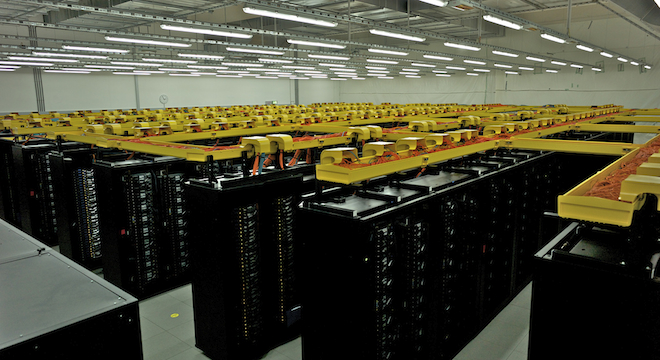The United States has retaken the lead when it comes to raw supercomputing power for the first time since 2009, but a German supercomputer that’s not far behind displays a more efficient and eco-friendly way of cooling its ultrafast processors — using a hot-water system.
Both of the computers in question are the work of scientists at IBM, and both made the ranks of the Top 500 Supercomputer Sites, a bi-annual list compiled by U.S. and German researchers beginning in 1993.
Taking the most powerful spot this time around was IBM’s Sequoia BlueGene/Q located at the Lawrence Livermore National Laboratory in Livermore, California, designed to run complex computer simulations on the U.S. nuclear weapons stockpile without actually detonating any of the arms.
The Sequoia system, which clocked in at 16.32 petaflops (16.32 quadrillion floating-point operations) on the LINPACK test for supercomputing performance, just recently booted up, after having its 96 separate racks installed at Lawrence Livermore over the first five months of the year. Lawrence Livermore and IBM note that the system actually has a 20 petaflops upper limit, so it could get even more powerful once it actually begins operations this Fall.
In comparison, the second-place finisher on the new top 500 list, Japan’s K Supercomputer, in Kobe, reached a maximum operating performance rate of 10.51 petalops, the same value that had vaulted it into the first place spot six months ago.
IBM had previously predicted that its new supercomputer would take the top spot.
But the Sequoia system is also notable for its advances in energy efficiency. It’s 91 percent liquid-cooled, according to Lawrence Livermore, compared to the more common historical method of cooling supercomputers, using extensive arrays of fans. This allows the Sequoia system to achieve more performance while simultaneously consuming less electricity, 7.9 megawatts compared to the Japanese K supercomputer’s 12.7 megawatts, as the blog Gizmag noted.
Still Seqouia is not the most energy-efficient machine on the list: That honor belongs to another IBM supercomputer that placed not far behind, at number 4, Germany’s recently-installed SuperMUC supercomputer located in Leibniz.
The SuperMUC, which was designed by IBM for the German government to be used for any research project that wins approval (it will initially be used to model plate tectonics and earthquakes initially) attained a performance score of 2.9 petaflops, but uses just 3.4 megawatts of power.
In addition, the SuperMUC is entirely liquid cooled, and actually uses a hot-water cooling system to take heat generated by the supercomputer’s operations and uses it as hot water for the buildings it and its researchers reside in.
IBM provides more detail about the system and the supercomputer itself in the following video:
SuperMUC uses 40 percent less energy than if it were air-cooled, according to IBM. The hot-water cooling system also aids in fulfilling a new German countrywide mandate that all state-sponsored institutions consume only 100 percent sustainable energy.
Intriguingly, IBM developed SuperMUC’s cooling system through a kind of biomimicry, noting that the brain, which is much more powerful than even today’s leading supercomputers, is far more efficient at cooling itself than those systems as well.
“We copied the bionic design of the human brain,” said Bruno Michel, IBM manager of advanced level packaging, in a phone interview with TPM. “When you consider the way that supercomputers are housed, the computing processors themselves only fill a very small portion of the total volume, 95 percent or greater is used just for air cooling. We want to squeeze out the air.”
Michel told TPM that the IBM team that developed the SuperMUC system was working to expand the technology to other, less lofty applications, such as the ordinary server farms employed by the likes of Google and Facebook, which are in something of an efficiency arms race and are constantly being critiqued by environmental groups like Greenpeace.






